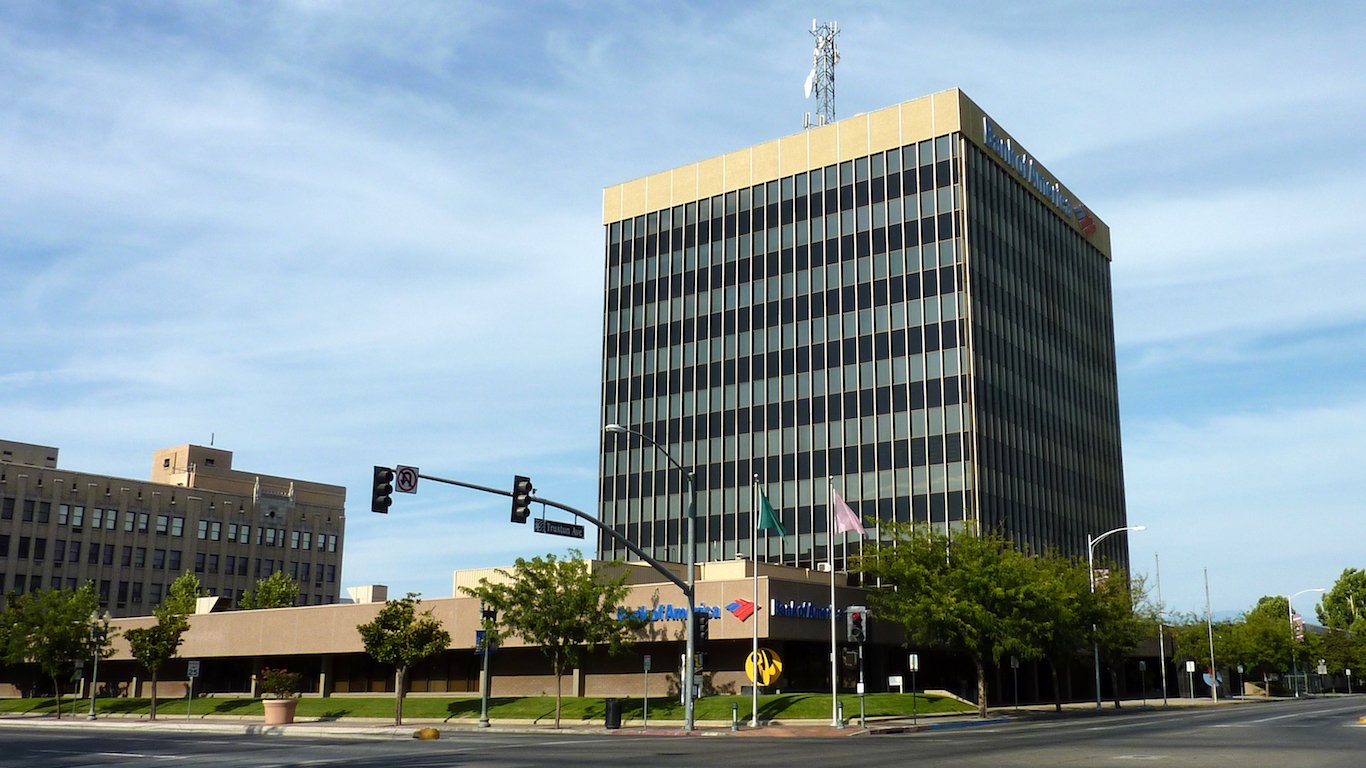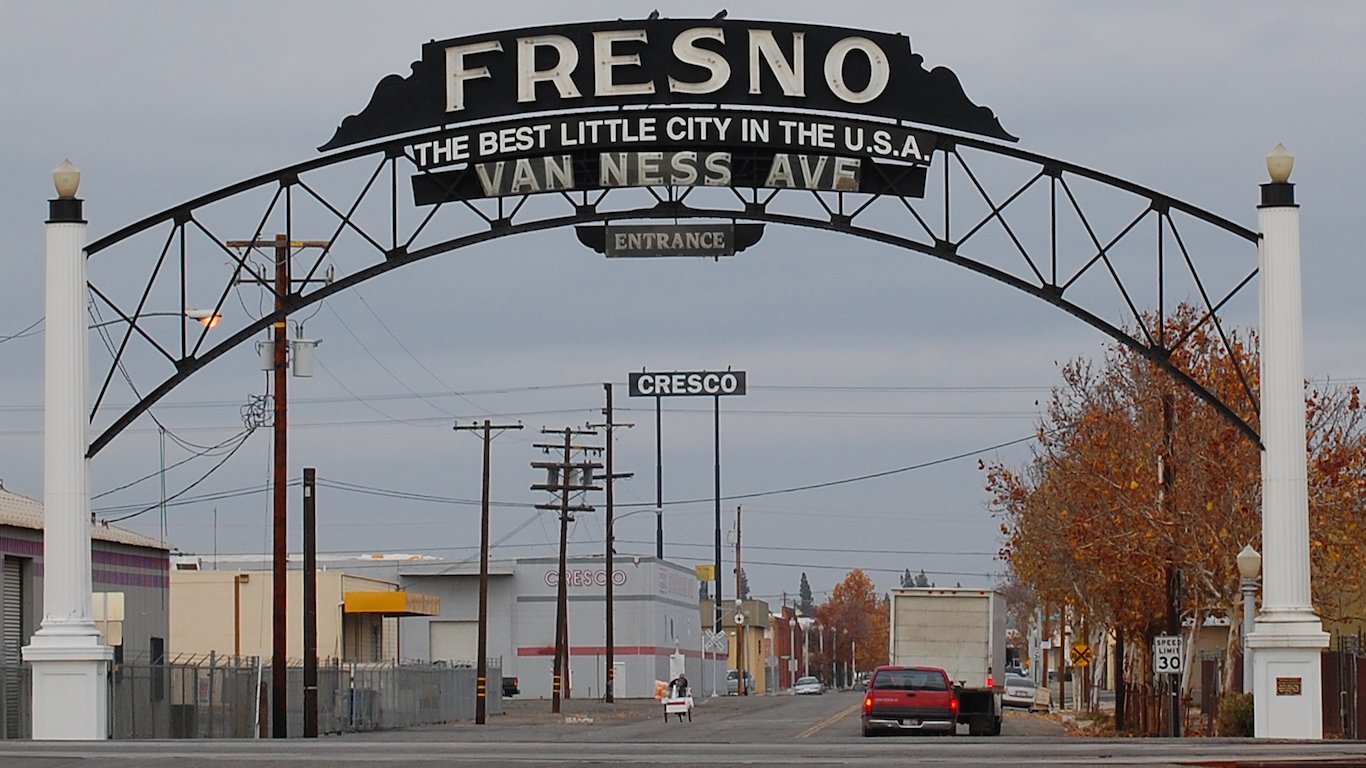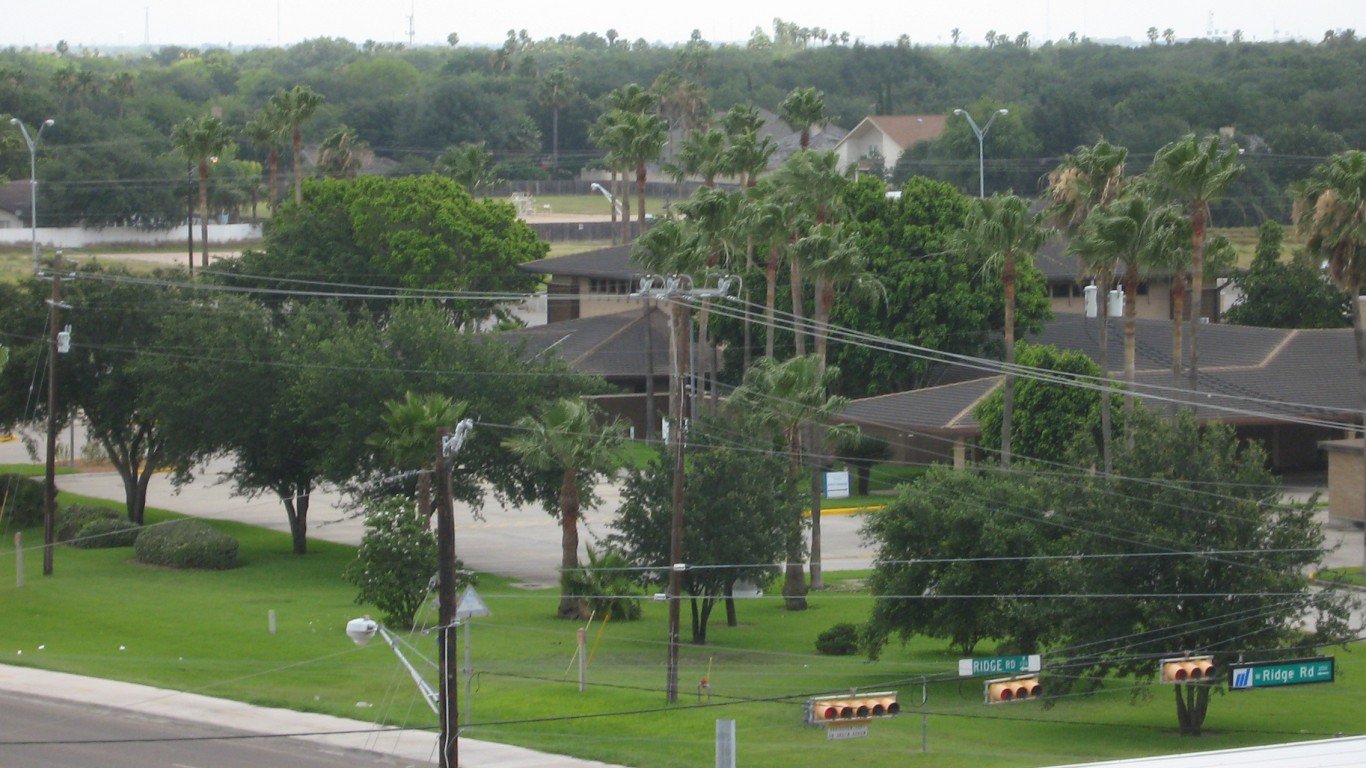Special Report
Cities With the Most Idle Youth
Published:
Last Updated:

From the ages of 16 to 19, most American teens complete a high school education that qualifies them for further educational attainment or a job. Between ages 20 to 24, most young adults go to college or begin their professional careers. Individuals who do neither — defined as disconnected youth — miss out on invaluable experience and opportunities. To identify the cities with the most disconnected youth, 24/7 Wall St. analyzed U.S. Census microdata compiled by the Brookings Institution.
[in-text-ad]
The years between ages 16 and 24 can set the stage for a person’s entire life. In an interview with 24/7 Wall St., Martha Ross, fellow at the Brookings Institution, said, “They’re at this transition point in their lives. But if you have low levels of education and you are not working, then you are really at a disadvantage. When you’re not working, it’s more likely that you’ll continue to not work.” In other words, America’s disconnected youth are less likely to do well later in life.
Click here to see the 10 cities with the most idle youth
In most metropolitan areas, the social and economic conditions of young adults mirrors the adult population. In every metropolitan area in which more than one in 10 young resident is neither a student or a worker, the poverty rate is higher than the national rate of 15.5%.
Families living in poverty are less likely to be able to afford to send their children to college or to live in areas with better public schools. Many studies suggest that whether parents finished high school or not has a powerful influence on whether their children finish high school as well.
Nationwide, 30.1% of adults have a bachelor’s degree. In all 10 of the metropolitan areas with the largest shares of disconnected youth, city adults have lower college attainment rates than the national rate. In Bakersfield, California, just 15.4% of adults have a bachelor’s degree.
The disconnected youth rate in the United States has not changed materially from 10 years ago. According to a study by Measure of America, a nonprofit program of the Social Science Research Council, despite many efforts to address the problem, the disconnected youth rate has remained largely unchanged.
Looking at the other end of the spectrum, in some of the wealthiest metropolitan areas the disconnected youth rates are lower than 3%. When a city has a healthy economy with educated residents, young adults are more likely to go to college and have a higher chance of finding employment. Also, many wealthy cities may attract new college graduates that dilute the share of disconnected youth.
To identify the cities with the most disconnected youth, 24/7 Wall St. analyzed microdata from the U.S. Census Bureau compiled by the Brookings Institution. Residents between 16 to 24 years old are considered disconnected youth if they meet all of the following criteria: not working as the result of being either unemployed or not in the labor force, not enrolled in school, living below 200% of the federal poverty line, have educational attainment less than an associate degree, not in the armed forces, and not living in non-household arrangements such as dorms or correctional facilities. This is the definition of disconnected youth as defined by Brookings. Poverty rate, educational attainment, and racial composition for metropolitan areas came from the U.S. Census Bureau’s 2015 American Community Survey. The general unemployment rate came from the Bureau of Labor Statistics and is for April 2016.
These are the cities with the most disconnected youth.

10. Birmingham-Hoover, AL
> Disconnected youth rate: 10.1%
> Overall unemployment rate: 5.1%
> Median household income: $47,046
> Pct. adults with bachelor’s degree: 28.2%
In Birmingham-Hoover, more than one in 10 residents between the ages of 16 and 24 years old are neither working nor enrolled in school. Disconnected youth tend to be the product of the community’s socioeconomic issues, and overall, Birmingham-Hoover has above average poverty and unemployment rates.
While Birmingham-Hoover’s 19.5% unemployment rate for 16 to 19 year olds is somewhat better than the 22.5% national unemployment rate for the same age cohort, finding employment after high school is more difficult in the city. Nearly one in five 20 to 24 year olds are unable to find work, the fifth highest unemployment rate for the age group in the country.
[in-text-ad]

9. Stockton-Lodi, CA
> Disconnected youth rate: 10.3%
> Overall unemployment rate: 8.1%
> Median household income: $51,659
> Pct. adults with bachelor’s degree: 18.3%
It is more difficult to find a job in Stockton-Lodi than in nearly any other city in the country. The metro area’s 8.1% unemployment rate is the third highest nationwide, and it is far higher for its younger residents. Those seeking work are likely to be less qualified than applicants in many parts of country. Just 77.6% of adults in the area have at least a high school diploma, and just 18.3% have a bachelor’s degree, each some of the lowest attainment rates of any metro area.
Children raised in Stockton are more likely to miss out on key educational and employment experiences. Of those aged 16 to 24, 10.3% neither work nor are enrolled in enrolled in school..

8. El Paso, TX
> Disconnected youth rate: 10.6%
> Overall unemployment rate: 4.5%
> Median household income: $40,133
> Pct. adults with bachelor’s degree: 21.0%
Just 75.6% of adults in El Paso have at least a high school diploma, one of the lower shares nationwide. Children whose parents did not graduate are themselves less likely to finish high school. This may be one reason why 10.6% of young residents aged 16 to 24 in El Paso are disconnected — neither working nor enrolled in school — one of the larger shares of any metro area.
Latino youth are about three times as likely as white youth to be disconnected. More than four in five El Paso residents is Hispanic, nearly the largest proportion in the country. Hispanic and Latino 16 to 24 year olds make up 84.8% of all El Paso disconnected youth, a larger share than in any metro area than McAllen-Edinburg-Mission, another border town.

7. Knoxville, TN
> Disconnected youth rate: 11.1%
> Overall unemployment rate: 3.6%
> Median household income: $45,151
> Pct. adults with bachelor’s degree: 27.6%
More than one in every 10 young Knoxville residents are disconnected — neither working nor in school. Young members of minority groups are more likely to be disconnected than their white counterparts, and in the majority of cities with more disconnected youth, relatively small shares of the population are white. However, 87.3% of Knoxville’s population is white, the highest share in the country among large metropolitan areas.
The situation is even worse for Knoxville’s very young adults, compared to the 20-24 year olds. More than 7% of 16 to 19 year olds are disconnected, the fourth highest share among large metropolitan areas.

6. Lakeland-Winter Haven, FL
> Disconnected youth rate: 11.4%
> Overall unemployment rate: 5.0%
> Median household income: $42,780
> Pct. adults with bachelor’s degree: 19.7%
Among Lakeland metro area’s young residents, 11.4% are currently unemployed and not receiving an education. Among the 20 to 24 year olds, the situation appears to be even worse, as 15.7% of this age group is disconnected. One likely cause for this problem is the extremely low employment rate in the metro area. Barely 60% of 20 to 24 year olds in Lakeland have a job, and less than 20% of 16 to 19 year olds are employed, each among the lower rates among major metropolitan areas.

5. Winston-Salem, NC
> Disconnected youth rate: 11.6%
> Overall unemployment rate: 4.7%
> Median household income: $43,665
> Pct. adults with bachelor’s degree: 25.2%
Education is one of the more important determinants of gainful employment. Just 85.2% of Winston-Salem adults have at least a high school diploma, and just 25.2% have at least a bachelor’s degree, each lower than the corresponding national rates. When adults have less educational background, they have greater difficulty finding jobs, especially higher-paying jobs. Also, their children are less likely to attend school or find employment.
According to Brookings, youth are more likely to be disconnected — neither working nor in school — when they are 20 to 24 years of age than when they are 16 to 19 years old. Without an education, it becomes more difficult to find a job. One in every four 20 to 24 year olds in Winston-Salem is unemployed, the highest such proportion of any major metro area.
[in-text-ad]

4. Memphis, TN-MS-AR
> Disconnected youth rate: 11.9%
> Overall unemployment rate: 4.4%
> Median household income: $45,844
> Pct. adults with bachelor’s degree: 26.4%
Across the country, African American youth are more than twice as likely than white American youth to be disconnected — out of school and out of work. In Memphis, where African Americans make up 45% of the population, African American youth are even more likely to be neither working nor in school. While African Americans make up 25.3% of disconnected youth nationwide, in Memphis they make up 78.8% — the largest such share of any metro area.
Disconnected youth are more likely to remain unemployed later in life as well as engage in criminal behavior. More than one in five Memphis residents live in poverty, one of the higher poverty rates of any major metro area. There are also 1,034 violent crimes reported in Memphis per 100,000 residents, the most of any major metropolitan area considered and almost three times the national rate.

3. Bakersfield, CA
> Disconnected youth rate: 12.4%
> Overall unemployment rate: 10.6%
> Median household income: $47,644
> Pct. adults with bachelor’s degree: 15.4%
Just 74.5% of adults in Bakersfield have at least a high school diploma, far lower than the 86.9% national high school educational attainment rate. Those residents without diplomas may find it more difficult to land a job. The unemployment rate among 20 to 24 year olds in Bakersfield is 23.1%, the second highest of any major metropolitan area.
Latino and foreign-born youth are far more likely to be disconnected — neither working nor in school — than white Americans. In Bakersfield, more than half the population is Hispanic or Latino. Further, city youth are somewhat more likely to be disconnected than the typical Hispanic and Latino American.

2. Fresno, CA
> Disconnected youth rate: 12.9%
> Overall unemployment rate: 9.7%
> Median household income: $43,423
> Pct. adults with bachelor’s degree: 19.7%
Nearly 13% of Fresno’s youth are disconnected — they do not have a job and are not currently furthering their education. Just one in five 16 to 19 year olds are employed, and less than 60% of 20 to 24 year olds have a job, each among the lowest rates among large metropolitan areas.
As is often the case in places with large shares of disconnected youth, the problems of the youth are a reflection of more general problems. For example, the high unemployment rate among young adults extends to the overall population. Fresno’s unemployment rate among 25 to 54 year olds of 10.8% is the highest in the country and is much higher than the national rate of 6.2%. Similarly, it is not surprising that a large share of Fresno’s youth is not pursuing higher education considering that many older adults never did so either. Less than 20% of Fresno’s adults have a bachelor’s degree, versus a national share of 30.1%.

1. McAllen-Edinburg-Mission, TX
> Disconnected youth rate: 13.9%
> Overall unemployment rate: 7.2%
> Median household income: $34,801
> Pct. adults with bachelor’s degree: 17.9%
Poor and minority communities tend to have disproportionately larger shares of disconnected youth. McAllen-Edinburg-Mission is 91.2% Hispanic and Latino, and 34.0% of its residents are living in poverty, each the largest such share of any major metropolitan area. Hispanic and Latino residents are about twice as likely to be out of school and out of work as white Americans, and even more so in McAllen. Of all 16 to 24 year olds in the metro area, 13.9% are both out of work and out of a job, the highest rate of disconnected youth of any of the 100 largest metropolitan areas.
For many disconnected youth, it is not their choice to be neither in school nor employed. With an overall unemployment rate of 7.2%, it is more difficult to find a job in McAllen than it is in almost any other city nationwide.
A financial advisor can help you understand the advantages and disadvantages of investment properties. Finding a qualified financial advisor doesn’t have to be hard. SmartAsset’s free tool matches you with up to three financial advisors who serve your area, and you can interview your advisor matches at no cost to decide which one is right for you. If you’re ready to find an advisor who can help you achieve your financial goals, get started now.
Investing in real estate can diversify your portfolio. But expanding your horizons may add additional costs. If you’re an investor looking to minimize expenses, consider checking out online brokerages. They often offer low investment fees, helping you maximize your profit.
Thank you for reading! Have some feedback for us?
Contact the 24/7 Wall St. editorial team.